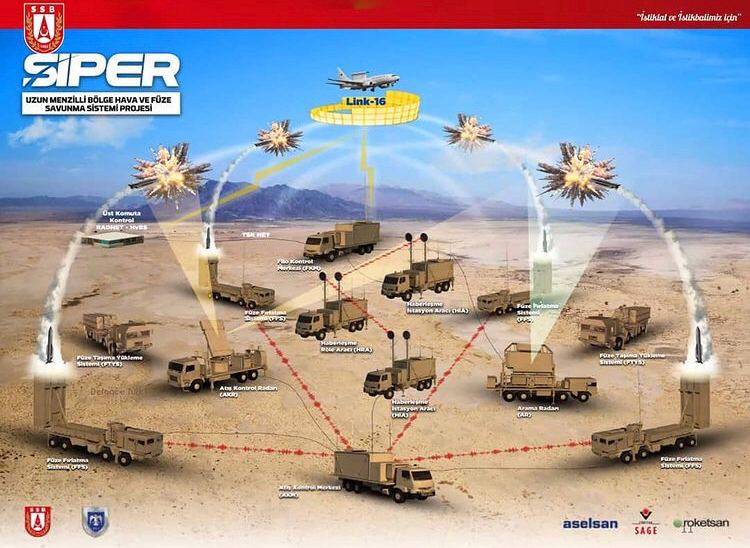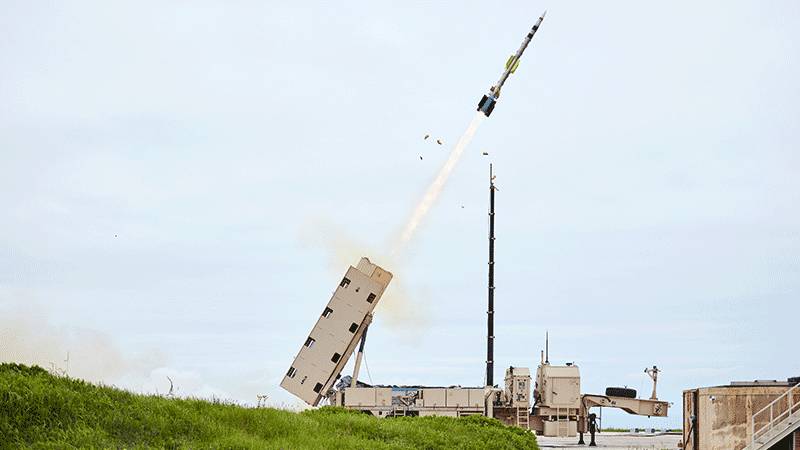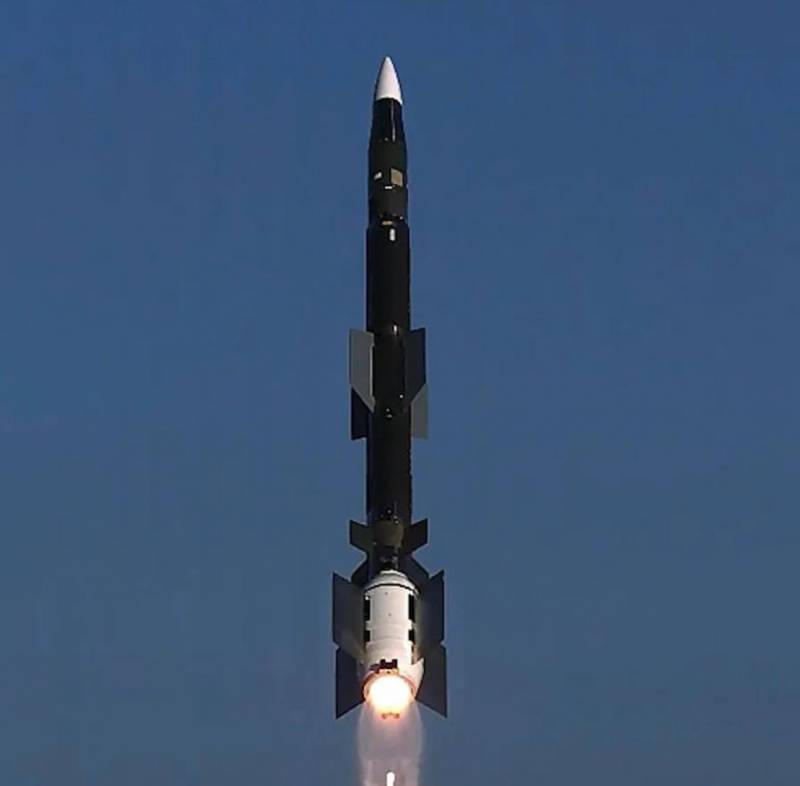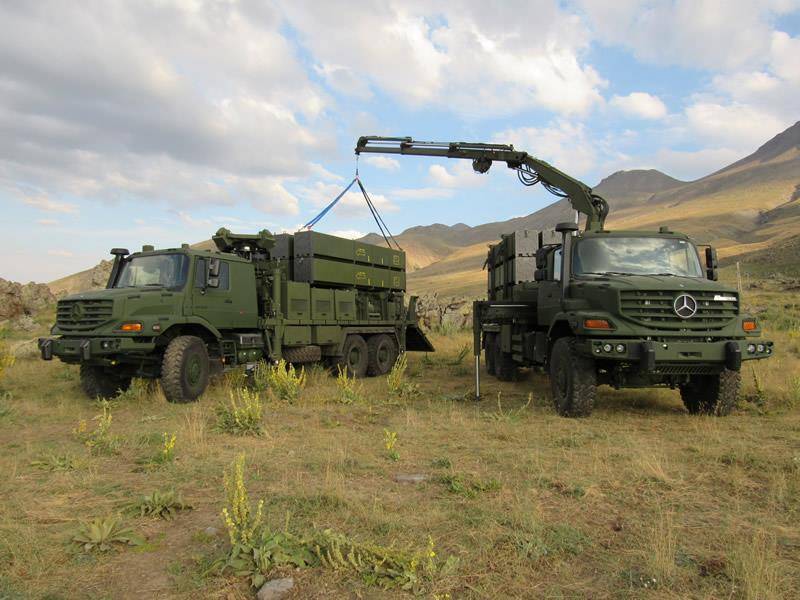Siper air defense system - a new air defense system for the Turkish army

The architecture of the Siper complex and the functions of its facilities
At the end of the XNUMXs, the Turkish defense industry began developing its own anti-aircraft missile systems. To date, it has created and brought into operation several such samples, and the latest of them was the Siper long-range air defense system. It recently passed the necessary tests and confirmed its design characteristics. By the end of the year it will enter service with the troops and will complement existing systems and complexes.
Perspective development
The development of promising Turkish air defense systems for object air defense began in 2007 at the initiative of the armed forces. All leading organizations of the defense industry, commercial and government were involved in the work. Over the next 10-12 years, the result of these efforts were several complexes of the Hisar ("Fortress") series of short, medium and long ranges.
In 2018, a new long-range air defense system project called Siper (“Barrier” or “Trench”) was launched. Its task was to create a long-range complex capable of intercepting aerodynamic targets at distances of at least 100-120 km. At the same time, it was planned to use developments on existing “Fortresses”, which at that time were already being prepared for adoption.
The development of the Siper product was entrusted to Roketsan and Aselsan - they were responsible for the rocket and ground assets, respectively. The Defense Institute TÜBİTAK SAGE was supposed to provide them with the necessary scientific and technical support. It was expected that the development of a promising air defense system through joint efforts would take about five years.
In 2020, the project participants presented the concept of the new Siper complex for the first time, and also revealed some of the goals and details of this project. By the autumn of next 2021, design work was completed, after which preparations began for future tests. Test launches soon took place, and in November the project participants held an official presentation.

Siper rocket test launch
During the tests, the operation of various means of the complex was tested, and the design characteristics were gradually achieved. Thus, at the end of last year, the Siper missile hit an aerial target for the first time at a range of more than 100 km. Fire tests continued until May 2023. During these events, the experienced air defense system demonstrated all its capabilities and confirmed the declared parameters.
According to recent statements by Turkish officials, the new Siper air defense system will enter service with air defense units of the Air Force this year. At the same time, the production and deployment of a full-fledged group of air defense systems of various types, including the latest long-range system, will take several more years.
Long range complex
The Siper product is a multi-component anti-aircraft missile system designed to organize air defense of large areas and important objects. All components of this air defense system are made on MAN Türkiye truck chassis or on semi-trailers that allow movement between positions. Combat work is carried out only from the spot and after quite a long preparation.
The Siper air defense system has a standard composition for such systems. The overall coordination of the complex’s operation is carried out by the control point, to which the detection and fire control radars are connected. The battery also includes several missile launchers, transport-loading vehicles, etc. The complex's equipment interfaces and interacts via radio.
The regular detection radar from the Zaslon is equipped with AFAR and provides airspace surveillance within a radius of more than 150-200 km. At the same time, up to 100 objects are tracked, recognized and distributed according to their importance. Data on the air situation is transmitted to the control center, which processes it and issues commands to the launchers. The control point has NATO-standard communications, which allows it to receive target designation from any other radars and air defense systems in service with the Turkish army.

The launcher on a special four-axle chassis carries six anti-aircraft missiles in a transport and launch container. The battery may include four or more such vehicles, which provides a ready-to-use ammunition load of at least 24 missiles.
The missile of the Siper complex is built according to the traditional scheme for such products. An elongated cylindrical body with planes on the outside is used. The dimensions and weight indicators of such missiles have not yet been specified. A semi-active radar homing head was used, requiring target illumination from the ground. The defeat is carried out using a high-explosive fragmentation warhead.
The Siper missile defense system is equipped with a solid-fuel rocket motor and thrust vector control. The start is carried out vertically, after which the product is turned in the desired direction. Flight speeds and available overloads are not reported. The maximum range is stated at 100-120 km. The height of target destruction is from 100 m to 30 km.
It is already known about the development of new versions of the rocket. So, the Siper Block I product will be more perfect in terms of design and will be able to show higher performance. In the next Block II project, they are going to bring the flight range to 150 km and introduce a new active radar seeker.
According to the developer, the Siper air defense system can deal with a wide range of air attack weapons. It detects and shoots down aircraft of various classes, UAVs, aviation means of destruction, etc. The possibility of intercepting ballistic targets has not yet been reported. Perhaps it will appear during further modernization of the complex.

Hisar-O medium-range air defense system during launcher reloading
New successes
In recent years, Turkish industry has demonstrated significant success in the field of air defense. In 2021, the first complexes of the Hisar family entered service with the Turkish air defense system, of two types at once. Then the newer and more advanced Siper air defense system was tested, and the first products of this type are expected to arrive in the troops in the near future.
Based on the results of completed design work and through mass production of new equipment, the Turkish armed forces will be able to significantly update and improve their territorial air defense. This will lead to an increase in the basic characteristics and overall defense capabilities with understandable consequences for national security as a whole.
Defense at short ranges, up to 15-25 km, will be carried out by the Hisar-A and Hisar-O complexes. In the range of 25-100 km, the main vehicle will be the longer-range Siper, expected this year. At longer ranges, interception will be carried out by the Russian S-400 system, delivered several years ago.
Thus, any attack weapon threatening Turkish targets will have to go through several echelons of air defense with different characteristics and features. At the same time, Turkey is going to improve the existing “Fortresses” and the new “Barrier”, increasing their key characteristics. The first results of this process will reach the troops in the coming years.
Consistent development
In general, the latest successes of Roketsan, Aselsan, TÜBİTAK SAGE, etc. show that the Turkish defense industry has mastered the development and production of modern air defense systems, and is also moving forward. Gradually, more complex means and missiles with improved characteristics are being created.
However, the development of a complex with parameters at the level of the Russian S-300P or S-400 still remains an extremely difficult task, and such equipment has to be purchased abroad in finished form. At the same time, Turkish industry intends to do everything possible to catch up with the world leaders in the industry. Time will tell how successful this process will be and when it will produce the desired results.
Information